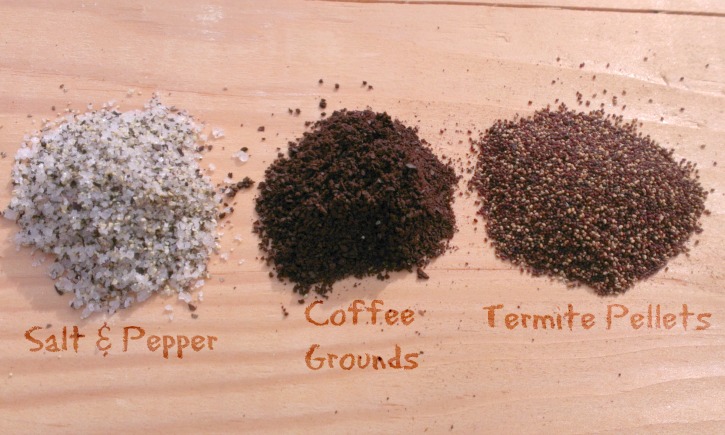Home Improvement
- Thread starter Picasso3
- Start date
You are using an out of date browser. It may not display this or other websites correctly.
You should upgrade or use an alternative browser.
You should upgrade or use an alternative browser.
- 8,089
- 21,234
So, I swear, I only have one project currently ongoing and I come bearing more questions.
I'm doing a reno on a guest bath and pulling out the 20-40 year old drywall backing on the tile surround, found a TON of what looked like pepper pressed to the studs, come to tear out the wet wall and that pepper shit is everywhere and I'm GUESSING it is termite damage.
On that note, anyone have dealings with insurance and termite damage? Will insurance cover replacing things damaged by termites or am I generally on my own?
Follow-up to that...
SHOULD I worry about replacing studs damaged by termites? Unfortunately this is a shared wall between bathrooms so it's going to turn into a nightmare job of juggling projects replacing studs. LUCKILY it looks like the baseboards (? the shit the studs are sitting on the house is Slab on Grade) and studs are intact on the non-wet walls but the surround Wetwall is entirely fucked. The baseboards on the surround wetwall are Swiss cheese as well.
Here is a shot of "Pepper" stuff:

And the damage of the boards:


I'm doing a reno on a guest bath and pulling out the 20-40 year old drywall backing on the tile surround, found a TON of what looked like pepper pressed to the studs, come to tear out the wet wall and that pepper shit is everywhere and I'm GUESSING it is termite damage.
On that note, anyone have dealings with insurance and termite damage? Will insurance cover replacing things damaged by termites or am I generally on my own?
Follow-up to that...
SHOULD I worry about replacing studs damaged by termites? Unfortunately this is a shared wall between bathrooms so it's going to turn into a nightmare job of juggling projects replacing studs. LUCKILY it looks like the baseboards (? the shit the studs are sitting on the house is Slab on Grade) and studs are intact on the non-wet walls but the surround Wetwall is entirely fucked. The baseboards on the surround wetwall are Swiss cheese as well.
Here is a shot of "Pepper" stuff:
And the damage of the boards:
- 3

Lanx
<Prior Amod>
no expert obviously, just google searched

looks like termite shit
How to Identify Drywood Termite Droppings | Thrasher Termite & Pest Control

looks like termite shit
How to Identify Drywood Termite Droppings | Thrasher Termite & Pest Control
- 1
- 8,089
- 21,234
no expert obviously, just google searched

looks like termite shit
How to Identify Drywood Termite Droppings | Thrasher Termite & Pest Control
I guess..thankfully...they are pellets and not eggs or something.
- 5,940
- 4,598
Are you going to die in this house or are you planning to sell it some day?So, I swear, I only have one project currently ongoing and I come bearing more questions.
I'm doing a reno on a guest bath and pulling out the 20-40 year old drywall backing on the tile surround, found a TON of what looked like pepper pressed to the studs, come to tear out the wet wall and that pepper shit is everywhere and I'm GUESSING it is termite damage.
On that note, anyone have dealings with insurance and termite damage? Will insurance cover replacing things damaged by termites or am I generally on my own?
Follow-up to that...
SHOULD I worry about replacing studs damaged by termites? Unfortunately this is a shared wall between bathrooms so it's going to turn into a nightmare job of juggling projects replacing studs. LUCKILY it looks like the baseboards (? the shit the studs are sitting on the house is Slab on Grade) and studs are intact on the non-wet walls but the surround Wetwall is entirely fucked. The baseboards on the surround wetwall are Swiss cheese as well.
Here is a shot of "Pepper" stuff:
View attachment 189289
And the damage of the boards:
View attachment 189290
View attachment 189291
- 8,089
- 21,234
Are you going to die in this house or are you planning to sell it some day?
I'm guessing a 10 year home and plans to retain when we leave for the sake of rental.
So whatever i do to it will likely haunt me later if I do it in a shitty way.
Lanx
<Prior Amod>
those termites aren't some union workers slouching around, they working overtime to get him out asap!Are you going to die in this house or are you planning to sell it some day?
- 1
- 5,940
- 4,598
I would repair it as well as your budget and skills allow for. If you want more specific advice, we’ve got some pretty handy guys in this thread.I'm guessing a 10 year home and plans to retain when we leave for the sake of rental.
So whatever i do to it will likely haunt me later if I do it in a shitty way.
- 5,940
- 4,598
Definitely do some homework on termites and insurance coverage. Keep in mind the deductible and the possibility that your premiums could increase after a claim.I'm guessing a 10 year home and plans to retain when we leave for the sake of rental.
So whatever i do to it will likely haunt me later if I do it in a shitty way.
- 8,089
- 21,234
I would repair it as well as your budget and skills allow for. If you want more specific advice, we’ve got some pretty handy guys in this thread.
Main question is, are there termite proof options for replacement of these boards?
Debating going foil underlay if need be but I'm getting conflicting reports on if pressure treated lumber is termite resistant or termite proof.
Lanx
<Prior Amod>
lulz what shitty shit insurance is.Definitely do some homework on termites and insurance coverage. Keep in mind the deductible and the possibility that your premiums could increase after a claim.
you crash into a car, your prems go up, SURE, thats FINE!!! you fucked up
you get rear ended, your prems go up, WTF!
a tree falls on your house, your prems go up, WTF!
termites decide to snack on your house, your prems go up, WTF!
Lanx
<Prior Amod>
from orkin, best i can googleMain question is, are there termite proof options for replacement of these boards?
Debating going foil underlay if need be but I'm getting conflicting reports on if pressure treated lumber is termite resistant or termite proof.
What Wood Will Termites Not Eat?
Home-invading termites prefer soft, rotting, or fungus-infested wood with high moisture content. For this reason, most termite infestations start with wood that touches or is located close to the soil. Homeowners may reduce the chances of termite infestations by using pressure treated, naturally resistant, or composite wood.
Pressure Treated
Pressure treated wood is embedded with preservatives that are forced into the wood pores during the manufacturing process. This makes the timber resistant to rot and fungi and creates a termite-resistant chemical barrier. Slowing the natural decay process in this way results in stronger, longer-lasting wood that is valuable for building homes, sheds, and decks. In fact, many locations within the U.S. have requirements for using pressure treated wood in places where the wood contacts or is otherwise close to the soil.
Naturally Resistant
Heartwood is the non-living, central wood of trees. This wood is darker, denser, and less permeable than the surrounding timber. Therefore, it is naturally less attractive to termites. To deter the pests, homeowners can obtain heartwood-grade lumber for construction projects. Termites also tend to avoid specific species of trees such as redwoods, yellow cedar, Laotian teak, and cypress. However, these types of wood are not as long-lasting as treated lumber.
Composite Materials
Specially designed to deter termites and increase the useable lifetime, some manmade composite lumber products are made with materials that the pests can’t digest, such as plastic. Other composite products are made with a combination of plastics and wood fibers. Since composites don’t tend to warp like natural timber, composite wood is also a more durable building product choice.
looks like pressure treated is the way to go?
- 5,940
- 4,598
Sorry if I missed this in your original post, but why were the boards wet?Main question is, are there termite proof options for replacement of these boards?
Debating going foil underlay if need be but I'm getting conflicting reports on if pressure treated lumber is termite resistant or termite proof.
- 8,089
- 21,234
looks like pressure treated is the way to go?
Yeah looking at pressure treated now at big box. Not bad pricing but fuck me I am seeing termite trails up to the rafters.
The strange part is there is termite damage only on certain boards, like they were only after the drywall paper and nothing else and the damage they caused was mostly collateral.
---
Fuck me....they interspersed Kiln dried between treated wood. motherfucker fucking fuck god damnit fucking morons.
They fucking created the god damn bridge the termites needed to get attic access by putting in preseasoned wood for them to suck on.
For SOME reason they used kiln dried (red lines) "randomly" to attach drywall to, the damage to the treated (marked with shit tier "T") lumber seems entirely superficial as the termites were eating the drywall paper. and just shat their shit onto the treated but never touched it.
Sorry if I missed this in your original post, but why were the boards wet?
Because I think one of the owners at some point used tile glued to drywall as their tiling solution. Not even greenboard straight up drywall. I could have excused it a tad more if it was greenboard and glue but no, these people straight up backed tile with some glueish substance to drywall.
That system stayed in place...my guess...for about 10 years during which time the owners husband passed away and the entire house fell into a disrepair of sorts. Grouting fell away and then tiles started buckling allowing more and more water into the drywall.
Since it's a tub surround there is leakage to all the corners and that is where the decay was terrible, mainly of the drywall though, the wood looks fine.
Lanx
<Prior Amod>
is that outlet allowed since it's opposite a shower wall? idk i just see a blue box and i just know that as electrical, what room is that outlet going into?
- 5,940
- 4,598
I'd say at an absolute minimum you should see if there's still termite activity and treat for them with a DIY product. Not sure how much professional treatments cost, but if you've got the money for it, I'd have it treated. It'll protect you for years.Yeah looking at pressure treated now at big box. Not bad pricing but fuck me I am seeing termite trails up to the rafters.
The strange part is there is termite damage only on certain boards, like they were only after the drywall paper and nothing else and the damage they caused was mostly collateral.
---
Fuck me....they interspersed Kiln dried between treated wood. motherfucker fucking fuck god damnit fucking morons.
They fucking created the god damn bridge the termites needed to get attic access by putting in preseasoned wood for them to suck on.
View attachment 189369
For SOME reason they used kiln dried (red lines) "randomly" to attach drywall to, the damage to the treated (marked with shit tier "T") lumber seems entirely superficial as the termites were eating the drywall paper. and just shat their shit onto the treated but never touched it.
Because I think one of the owners at some point used tile glued to drywall as their tiling solution. Not even greenboard straight up drywall. I could have excused it a tad more if it was greenboard and glue but no, these people straight up backed tile with some glueish substance to drywall.
That system stayed in place...my guess...for about 10 years during which time the owners husband passed away and the entire house fell into a disrepair of sorts. Grouting fell away and then tiles started buckling allowing more and more water into the drywall.
Since it's a tub surround there is leakage to all the corners and that is where the decay was terrible, mainly of the drywall though, the wood looks fine.
- 1
- 5,940
- 4,598
What would you do if you had access?How important is this?
My basement is finished, the ceiling is drywalled, i have no access to pipes or ductwork or anything, should i care? would anyone do paneling?
Lanx
<Prior Amod>
idk, i just want it? lulz nothing is broken, everything runs fine, aside from the furthest sink gets a frozen pipe on mega cold days.What would you do if you had access?
if thats a stupid reason, please say so, and wait until shit hits the fan when i "HAVE" to break down the drywall to access pipes to then replace with paneling.
Share:





